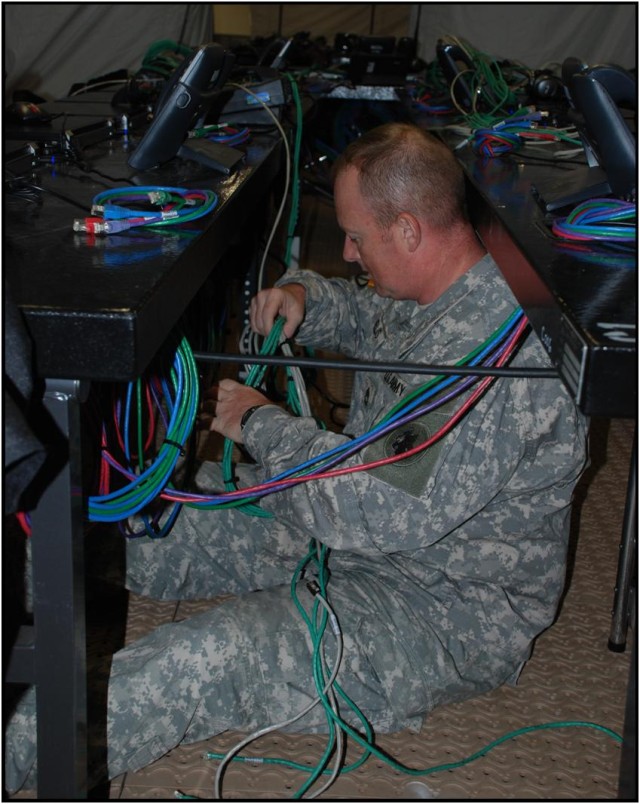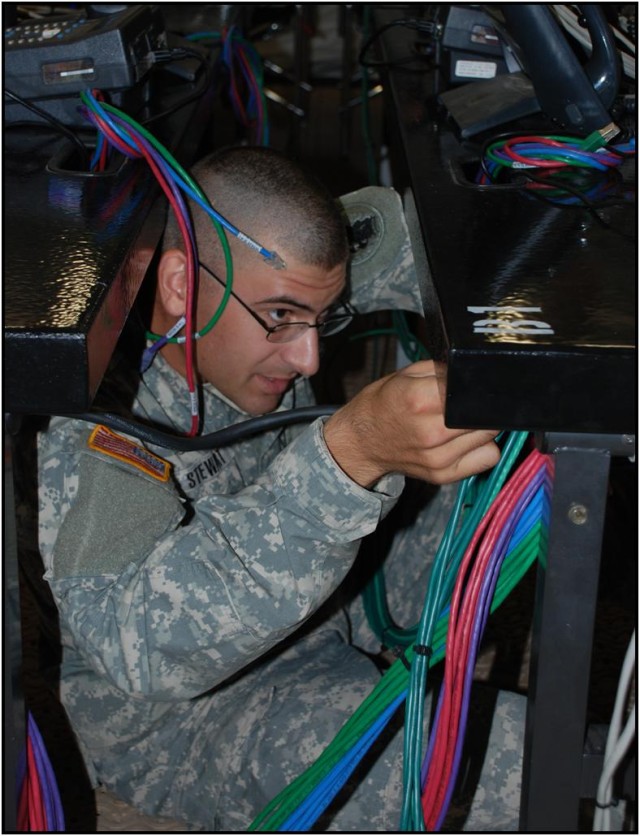FORT SAM HOUSTON, Texas (Aug. 5, 2009) - The relentless Texas heat is no match for the Soldiers of U.S. Army South as they built the command and control infrastructure here for "Fuerzas Aliadas PANAMAX 2009", an exercise scheduled to take place later this year. The command and control center, known as the Deployable Joint Command and Control, is the information hub for Army South, joint sister services, and partner nation coalition personnel to plan and conduct operations during the exercise.
PANAMAX is an annual exercise involving military and interagency personnel from the United States, Europe and South American countries focusing on the defense of the Panama Canal. This exercise expands the range of planning and operations in a multinational, multilingual headquarters and tests the ability of the exercise coalition to conduct combat operations, disaster relief and humanitarian assistance.
Soldiers from the Special Troops Battalion and the communications and operations directorates worked during the first week of July to inventory the tent system, environmental controlled units and computer hardware to prepare for a command and control systems rehearsal known as Event II. Event II training, conducted here July 20-24, is a computer exercise that focused on Battle Command System of Systems staff training, communications architecture tests, battle rhythm events, and the integration of U.S. Southern Command (SOUTHCOM) personnel into the Multinational Force South exercise staff.
Event II rehearsal was conducted to ensure connectivity of not only the systems in the DJC2, but connectivity with the main command post, here and Army South's higher headquarters, SOUTHCOM, located in Miami.
Once the mobile control center was constructed, the extensive computer network systems inside the facility had to be connected and tested to ensure operability. Staff Sgt. Albert F. Bartlett. Bartlett, a 10- year veteran and a network administrator for Army South, was responsible for ensuring all the complicated network systems in the DJC2 were operational.
"[If] one cable is missing it won't work; it's a big puzzle," Bartlett said.
As a network administrator for the DJC2 systems, Bartlett is concerned with the operational status and always has a plan for a system not functioning properly.
The system is set up so if there is a failure, it only affects one of the legs. Bartlett then can troubleshoot that particular leg to isolate the device that is malfunctioning and attempt to fix it or replace it.
"My whole job as network admin[istration] is to minimize the downtime of any network," said Bartlett.
When the Event II exercise began, Bartlett, along with other members of the Army South communications directorate, had the system operating and ready for other members to begin the exercise. Scenario events were submitted to drive the DJC2 staff into action, enabling participants to coordinate and synchronize operations with the main command post in order accomplish mission requirements.
"This specific training has prepared our team by providing a means to validate our procedures, train new teammates, and assess what we should sustain or improve between now and the exercise in September," said Col. Michael Feil, deputy commander of operations at Army South.
This year's training differed from last year in all three aspects of training, said Feil.
"The event series will allow us to integrate Army Command and Control systems, often referred to as the Army Battle Command System, into the exercise. This year we will use both the joint and army systems," said Feil. " Last year's training plan did not allow for a preparatory event like this, an event where we could not only set up the computer and communications systems, but also train with team members like officers from the U.S. Southern Command Standing Joint Force Headquarters."
In December, after the exercise is over and the system is recovered, Event III will allow Army South to validate the lessons learned and implement new procedures and prepare for future exercises or contingencies, Feil said.
Col. Robert Rhodes, director of communications at Army South, said that this "combined multilevel exercise provided an excellent opportunity to hone staff skills, while operating the latest [Army Battle Command System] family of systems."
The culmination of seven months of planning, fielding and training on Army Battle Command System has ensured Army South can effectively and efficiently perform command and control in a variety of operational environments, said Rhodes.
As the Event II training concluded, the participants had a better understanding of the systems utilized in the DJC2, and their capabilities to coordinate and synchronize operations to better prepare for the exercise later this year. But without the dedication and technical expertise of the Soldiers from the communications directorate working diligently to ensure the systems were operational, the Event II exercise would not have been a success for Army South.




Social Sharing